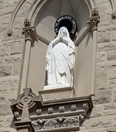Holy Communion: Difference between revisions
Appearance
| Line 6: | Line 6: | ||
== John 6: Bread of Life Discourse == | == John 6: Bread of Life Discourse == | ||
In the "Bread of Life Discourse", Jesus introduces the | |||
== Transubstantiation == | == Transubstantiation == | ||
| Line 45: | Line 46: | ||
***he did not deny the real presence of Christ but | ***he did not deny the real presence of Christ but | ||
[[ | [[Category:Bible]] | ||
[[ | [[Category:Mass and Liturgy]] | ||
[[ | [[Category:Catechism of the Catholic Church]] | ||
Revision as of 13:53, 1 February 2024
Holy Communion = becoming one (Communion) with God (Holy)
The Rite of Communion at the Mass during which the consecrated bread and wine are distributed to the faithful
Last Supper
John 6: Bread of Life Discourse
In the "Bread of Life Discourse", Jesus introduces the
Transubstantiation
Definition of Transubstantiation
The Council of Trent summarizes the Catholic faith by declaring: "Because Christ our Redeemer said that it was truly his body that he was offering under the species of bread, it has always been the conviction of the Church of God, and this holy Council now declares again, that by the consecration of the bread and wine there takes place a change of the whole substance of the bread into the substance of the body of Christ our Lord and of the whole substance of the wine into the substance of his blood. This change the holy Catholic Church has fittingly and properly called transubstantiation." (CCC 1376; emphasis added)
Etymology of transubstantiation
- from: trans- = across, beyond + substance ("what it is") (-tion = makes a noun)
- trans- = across, beyond
- substance = sub- (up to, under, made up of) + stare (that which stands, what is)
- stare has PIE root *sta- "to stand, make firm, be firm"
transubstantiation versus transformation
- trans-substance = changes form but not substance
- trans-form = changes its appearance while keeping its substance
- ex. water keeps its substance while changing form when solid, liquid or gas
- transform = trans- (across) + form (image, likeness, shape, appearance)
- i.e., change in shape, appearance
belief in transubstantiation
- In the Gospel of John Ch. 6, verses 47-51, Jesus says
"Amen, amen, I say to you, whoever believes has eternal life. I am the bread of life. Your ancestors ate the manna in the desert, but they died, this is the bread that comes down from heaven so that one may eat it and not die. I am the living bread that came down from heaven; whoever eats this bread will live forever; and the bread that I will give is my flesh for the life of the world.”
- the Church has accepted the doctrine and belief in transubstantiation from its beginning with the Apostles
- it was termed "transubstantiation" first in the 11th century
- after Berengar of Tours, a monk, denied the "material" change in the bread and wine into the Body and Blood of Christ
- he did not deny the real presence of Christ but
- after Berengar of Tours, a monk, denied the "material" change in the bread and wine into the Body and Blood of Christ
